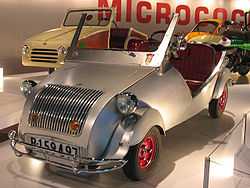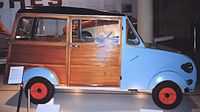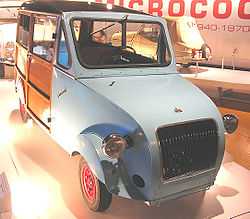Biscúter

Biscúter (Spanish spelling for the pronunciation of Biscooter) was a microcar manufactured in Spain during the mid-20th century.
Background
Raw material shortages and general economic difficulties in Europe following the Second World War made very small, economical cars popular in many countries. In Spain, following the Spanish Civil War and the embargo declared by the United Nations against General Francisco Franco's dictatorship, the situation was even worse. The combination of relative underdevelopment, war devastation and an international trade embargo meant that the country operated at a much lower economic level than the rest of Western Europe for nearly two decades and was forced to develop domestic substitutes for hard-to-get imported products and technologies. The Biscúter, tiny, simple, and cheap even by microcar standards, was a product of this economic environment and was well suited to its time and market.
Origins
The car had its origins in France in the late 1940s, where aircraft and car designer and manufacturer Gabriel Voisin had designed a minimal car called the Biscooter for Avions Voisin. The playful name implied that it was about the size of two motorscooters, or a scooter with four wheels. The design drew no interest from either manufacturers or consumers there, however, and he eventually licensed it to Spanish firm Autonacional S.A. of Barcelona. By the time it was introduced in 1953, the marque had been hispanicized to Biscúter. The first car had no formal model name and was called simply the Series 100, but it soon became known as the Zapatilla, or little shoe (clog), after a low-heeled peasant slipper popular at the time.
Technical information
The Zapatilla was minimal indeed, with no doors or windows or reverse gear. The 1 cylinder, 197 cc, two-stroke motor produced 9 horsepower (7 kW), had a crank starter, and drove only the right front wheel. Braking was by an unusual three-point system involving the transmission and cable ties to the two rear wheels. One genuinely advanced feature was an all-aluminum body, although steel was later used.
History

Biscúter flourished for about ten years and the cars became a common sight on Spanish roads, as well as a part of popular culture. ("Ugly as a Biscúter" was a common joke.) Amenities such as doors and windows did eventually appear, and several different bodystyles were produced, including trucks, an elegant woodie station wagon, and a toy-like sports car called the Pegasín (little Pegaso).
In 1950 the Spanish auto maker SEAT was set up as the country's national car manufacturer, but at first even the most inexpensive of its designs were considered luxury cars, out of reach of the average Spanish consumer. As time went on and a greater degree of prosperity developed, though, SEATs began to take more of the market and crowd out the cheaper marques. In 1957 the company attempted to produce a sports car, the Biscuter Pegasin in an attempt to attract the wealthier buyers. The styling was similar to the Pegaso Z-102, but it didn't help much. By the early 60s, Biscúter sales and production stopped, after a total production run of about 12,000. It is thought that almost all of the cars were eventually scrapped.
Today
Now Biscúters are mostly museum curiosities, although like many vanished marques they have some following among auto enthusiasts. The name is little-known outside Spain, however, and most materials pertaining to it are in Spanish. Their extreme rarity makes it likely that any surviving example would be a genuine collectible, although probably not one of an extremely high value.
External links
| Wikimedia Commons has media related to Biscuter vehicles. |

The Bruce Weiner Microcar Museum in Georgia has probably the best Biscúter collection in the United States:
A history of the marque in Spanish, with some interesting photos: